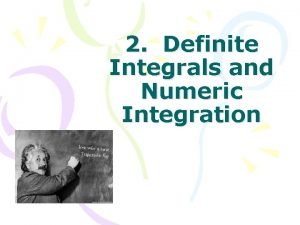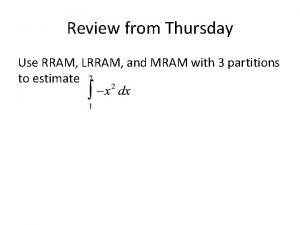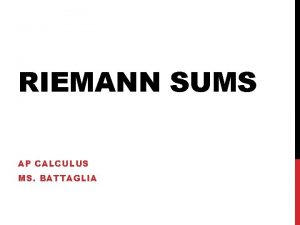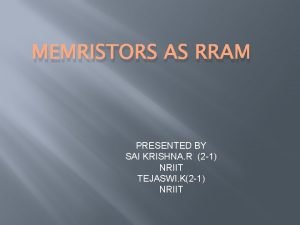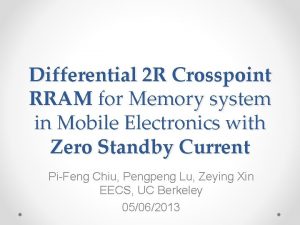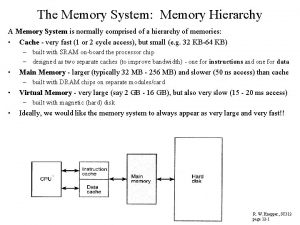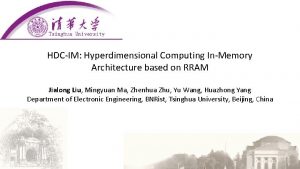Differential 2 R Crosspoint RRAM for Memory system






![Differential 2 R cell 1 cell WLa[1] BL 0 BL 1 BL 2 + Differential 2 R cell 1 cell WLa[1] BL 0 BL 1 BL 2 +](https://slidetodoc.com/presentation_image_h2/44d78884acb0721ceba4697811606cdf/image-7.jpg)









- Slides: 16

Differential 2 R Crosspoint RRAM for Memory system in Mobile Electronics with Zero Standby Current Pi-Feng Chiu, Pengpeng Lu, Zeying Xin EECS, UC Berkeley 05/06/2013

Outline • Introduction o Memory Hierarchy o RRAM switching mechanism • Issues of Crosspoint Array • Proposed Differential 2 R cell o Cell Characteristics o Differential 2 R cell and array design • Circuit Implementation o Divided WL and Sense-before • Simulation Results • Comparison • Conclusion

Memory Hierarchy Leakage issue Perfect Memory: Nonvolatile High speed Small Area Low power High Endurance ry d me mo gh eed sp Hi gh Cache L 1 L 2 Hi en sit y CPU Register Main Memory (DRAM) Permanent Storage Hard Disk Drive, Solid State Drive Slow

• • RRAM switching mechanism RRAM: Resistive Random Access Memory Sandwiched cell structure SET: Switching to Low Resistance State (LRS) RESET: Switching to High Resistance State (HRS)

Crosspoint Issues 1 T 1 R Crosspoint structure Leakage issues: Write – write energy efficiency Read – read margin Write Disturbance n: BL number, m: WL number (a) (b) (c)

Cell Characteristics • Tradeoffs o o o RLow vs. write energy Write time vs. Write voltage Write energy vs. Write voltage Read margin vs. Rlow Sensitivity to Write time
![Differential 2 R cell 1 cell WLa1 BL 0 BL 1 BL 2 Differential 2 R cell 1 cell WLa[1] BL 0 BL 1 BL 2 +](https://slidetodoc.com/presentation_image_h2/44d78884acb0721ceba4697811606cdf/image-7.jpg)
Differential 2 R cell 1 cell WLa[1] BL 0 BL 1 BL 2 + In read operation, WLa=Vread, WLb=0 Voltage-sensing VBL + VBL=Vread*Rb/(Ra+Rb) Ra Rb WLb[1] WLa[0] WLb[0] - Write-1 Write-0 Ra SET RESET Rb RESET WL Vwrite 0 BL 0 Vwrite Assumption: VSET=VRESET=Vwrite

Divided WL • To constrain overall write current to 100~200 u. A, WL length need to be set to 4 -cell wide • Divided WL: decouple local WLs and connect to global WL by switches. • Tradeoff between leakage current and area penalty GWLb GWLa … Ra Rb BEOL process enables stack ability LWLa LWLb BL SWa SWb

Sense-before-Write • Resistance value drops if a SET pulse repeatedly access to the cell. Lowest resistance value Targeted resistance value I(cell) • Solution: Write ? DIN Read DOUT If DIN= DOUT ? No Write Yes Pass

Block diagram

Write-0 Write-1 to cell 01 to cell 11 0 ~Vwrite/2 ~Vwrite SET RESET R 1 R 0 Write operation Read operation Vref

Features

Comparison Performance Active Power Standby Leakage Area Endurance Differential 2 R RRAM SRAM 500 MHz Large (DC current) 0 0. 04 um 2 (*) ~108 > 1 GHz Small (Static Logic) 570 p. J/cell 0. 1 um 2 (22 nm) >1014 *: assume metal width and space are 50 nm, area = (0. 05*4)2 Fit for L 2/L 3 cache in mobile electronics to save battery life

Conclusion • Differential 2 R crosspoint RRAM design o 64 KB RRAM circuit o Divided WL and Sense-before-Write approach o 28/32 nm PTM, RRAM cell model, Eldo simulator • Crosspoint RRAM Cache? o Area: yes o Power: depending on application o Endurance • Future Work: o Cell characterization o Leakage reduction, Cell distribution ?

Thanks!

• • • Reference ITRS Roadmap (http: //www. itri. net) Yan Li, et al. , “ 128 Gb 3 b/cell NAND Flash Memory in 19 nm Technology with 18 MB/s Write Rate and 400 Mb/s Toggle Mode, ” in IEEE Int. Solid-State Circuits Conf. (ISSCC) Dig. Tech. Papers, Feb. 2012, pp. 436 -437. T. Takashima, et al. , “A 100 MHz Ladder Fe. RAM Design With Capacitance-Coupled-Bitline (CCB) Cell, ” IEEE Journal of Solid-State Circuits, Vol. 46, No. 3, March 2011. T. Shigibayashi, et al. , “A 16 -Mb Toggle MRAM With Burst Modes, ” IEEE Journal of Solid-State Circuits, Vol. 42, No. 11, Nov. 2007. D. C. Ralph and M. D. Stiles, “Spin Transfer Torques, ” Journal of Magnetism and Magnetic Materials, vol. 320, issue 7, pp. 1190 -1216, April 2008. R. E. Simpson, et al. , “Toward the Ultimate Limit of Phase Change in Ge 2 Sb 2 Te 5, ” Nano Letter, pp. 414419, 2010. Elaine Ou and S. Simon Wong, “Array Architecture for a Nonvolatile 3 -Dimensional Cross-Point Resistance-Change Memory, ” IEEE J. Solid-State Circuits, vol. 46, no. 9, pp. 2158 -2170, Sep. 2011. R. Stanley Williams, “How we found the missing memristor, ” IEEE Spectrum, vol. 45, no. 12, pp. 28 -35, 2008. A. Kawahara, et al. , “An 8 Mb Multi-Layered Cross-Point Re. RAM Macro With 443 MB/s Write Throughput, ” IEEE Journal of Solid-State Circuits, Vol. 48, No. 1, January 2013. D. Niu, C. Xu, N. Muralimanohar, N. P. Jouppi, Y. Xie, “Design Trade-Offs for High Density Cross-Point Resistive Memory, ” ISLPED, 2012, pp. 209 -214. M. Yoshimoto, et al. , “A Divided Word-line Structure in the Static SRAM and Its Application to a 64 K Full CMOS RAM” IEEE Journal of Solid-State Circuits, Vol. 18, No. 5, Oct. 1983. P. Packan, et al. , “High Performance 32 nm logic technology featuring 2 nd generation high-k + metal gate transistors, ” in Int. Electron Devices Meeting (IEDM) Tech. Dig. Papers, Dec. 2009, pp. 659 -662.
 Rram formula
Rram formula Lram rram mram
Lram rram mram Rram calculus
Rram calculus Rram
Rram Rram
Rram Semantics prototype
Semantics prototype Explicit memory
Explicit memory Long term memory vs short term memory
Long term memory vs short term memory Internal memory and external memory
Internal memory and external memory Primary memory and secondary memory
Primary memory and secondary memory Logical and physical address in os
Logical and physical address in os Which memory is the actual working memory?
Which memory is the actual working memory? Virtual memory and cache memory
Virtual memory and cache memory Virtual memory in memory hierarchy consists of
Virtual memory in memory hierarchy consists of Eidetic memory vs iconic memory
Eidetic memory vs iconic memory Symmetric shared memory architecture
Symmetric shared memory architecture Fspos
Fspos
